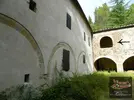QUANDO I PIU’ GRANDI MISTERI VERRANNO SVELATI, SARA’ IL SEGNO INEQUIVOCABILE CHE L’EPOPEA DELL’UOMO STA PER AVER FINE. PREGO IL “SIGNORE” DI FERMARE LA MIA MANO
Dunque un Cavaliere nero sarebbe stato istruito dal Romitone? Un romitone da sempre avvezzo a questa pratica da lui usata anche in epoche remote, per ammaliare personaggi storici, come ad esempio Bianco da L’Ancolina, religioso che soggiornò nel monastero della Sambuca. Ormai è nota la vicenda che narra di come il Romitone apparve al religioso, ma le cronache del tempo descrissero tale incontro in versione limitata dalla censura ecclesiastica. In realtà l’incontro ebbe una più profonda interazione che adesso andrò a descrivere: il Romitone, già signore e padrone in quei luoghi, udì un religioso pregare e recitare versi ad alta voce, percuotendosi con il pugno destro il petto furiosamente. Questo religioso era Bianco da L’Ancolina, venuto al monastero della Sambuca per visionare un testo sacro che trattava esclusivamente l’argomento inferi, purgatorio et paradiso. Nonostante ciò il religioso non riusciva a trovare risposte logiche nelle pagine del quel libro, per questo nella frustrazione più totale, egli si percuoteva poiché si sentiva in colpa per il fatto di non credere a ciò che leggeva. Fu proprio in quel frangente che il Romitone si manifestò dicendo: ”smetti di leggere quel libro, non voglio tu possa ferirti il cuore e turbare la mente nel cercare risposte che non potrai mai trovare, ma che io ti potrei dare. Tu vuoi sapere cosa sia l’inferno, ebbene, dovresti cercare nel passato, qui nel presente troverai pure il purgatorio, ma sappi che solo nel futuro esiste un paradiso”. Fu così che Bianco da L’Ancolina decise di tornare al tempo di quando da bambino venne violentato, per cercare, stavolta, di sfuggire a quell’inferno, ma questa è un’altra storia… che sta aspettando il suo futuro. Allego foto del punto esatto dove avvenne tale dialogo.
Pure il Capitano Leale Martelli volle tornare nel passato e vide l’inferno, ma fu grazie a quel viaggio che egli trovò le risposte che da sempre andava cercando. Fu facile per il Capitano intuire che la spirale nella quale veniva trascinato non era altro che il cordone ombelicale del tempo. Questo “cordone” alimentava la sua mente e lo inondava di conoscenza sottoforma di musica. Questo sapere era talmente grande da renderlo consapevole che solo un’elevata tecnologia poteva competere con la magia ed era la fusione di queste due potenze a generare la fede destinata agli uomini. Al Capitano stava per essere svelato il segreto della Trinità, quando all’improvviso…
English version
WHEN THE GREATEST MYSTERIES ARE REVEALED, IT WILL BE AN UNMISTAKABLE SIGN THAT THE EPIC OF MAN IS COMING TO AN END. I BEG THE "LORD" TO STOP MY HAND.
So a Black Knight would be instructed by the Romiton? A Romitone who has always been accustomed to this practice used by him even in ancient times to bewitch historical figures, such as Bianco da L'Ancolina, a religious man who stayed in the Sambuca monastery. By now the story of how Romitone appeared to the religious man is well known, but the chronicles of the time described this encounter in a version limited by ecclesiastical censorship. In reality the encounter had a deeper interaction that I will now go on to describe: the Romitone, already lord and master in those places, heard a religious man praying and reciting verses aloud, beating his chest furiously with his right fist. This religious man was White from L'Ancolina, who had come to the Sambuca monastery to view a sacred text dealing exclusively with the subject of the underworld, purgatory et paradise. Despite this, the religious could not find logical answers in the pages of that book, so in utter frustration, he beat himself up as he felt guilty for not believing what he read. It was at that very juncture that Romitone manifested himself by saying, "stop reading that book, I don't want you to hurt your heart and disturb your mind in looking for answers that you can never find, but that I could give you.
You want to know what hell is, well, you should look in the past, here in the present you may find purgatory, but know that only in the future is there a heaven." So it was that Bianco da L'Ancolina decided to go back to the time when he was raped as a child, to try, this time, to escape that hell, but that's another story ... which is waiting for its future. I attach photos of the exact spot where that dialogue took place.
Captain Leale Martelli, too, wanted to return to the past and saw hell, but it was through that journey that he found the answers he had always been searching for. It was easy for the Captain to intuit that the spiral in which he was being pulled was nothing more than the umbilical cord of time. This "cord" fed his mind and flooded him with knowledge in the form of music. This knowledge was so great that he was aware that only high technology could compete with magic, and it was the fusion of these two powers that generated the faith intended for men. The Captain was about to be told the secret of the Trinity, when suddenly...

